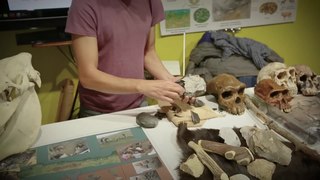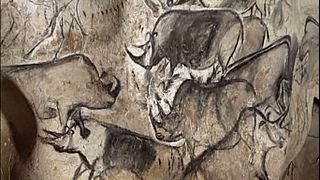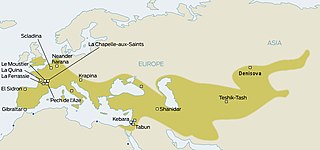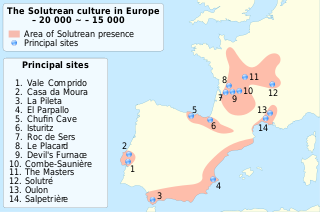 W
WIn the archaeology of the Stone Age, an industry or technocomplex is a typological classification of stone tools.
 W
WAcheulean, from the French acheuléen after the type site of Saint-Acheul, is an archaeological industry of stone tool manufacture characterized by distinctive oval and pear-shaped "hand-axes" associated with Homo erectus and derived species such as Homo heidelbergensis.
 W
WThe Ahmarian culture was a Paleolithic archeological industry in Levant dated at 46,000-42,000 BP and thought to be related to Levantine Emiran and younger European Aurignacian cultures.
 W
WThe Aurignacian is an archaeological tradition of the Upper Paleolithic associated with European early modern humans (EEMH) lasting from 43,000 to 26,000 years ago. The Upper Paleolithic developed in Europe some time after the Levant, where the Emiran period and the Ahmarian period form the first periods of the Upper Paleolithic, corresponding to the first stages of the expansion of Homo sapiens out of Africa. They then migrated to Europe and created the first European culture of modern humans, the Aurignacian.
 W
WThe Azilian is a name given by archaeologists to an industry in the Franco-Cantabrian region of northern Spain and southern France. It dates approximately 10,000–12,500 years ago. Diagnostic artifacts from the culture include Azilian points, crude flat bone harpoons and pebbles with abstract decoration. The latter were first found in the River Arize at the type-site for the culture, the Grotte du Mas d'Azil at Le Mas-d'Azil in the French Pyrenees. These are the main type of Azilian art, showing a great reduction in scale and complexity from the Magdalenian Art of the Upper Palaeolithic.
 W
WBohunician industry was a paleolithic archeological industry in South-Central and East Europe. The artifacts assigned to this culture are dated between roughly 48,000 and 40,000 years ago. They were found at the type site of Brno-Bohunice, Stránská skála (Moravia), Bacho Kiro and Temnata Cave (Bulgaria), Dzierzyslaw (Poland), and others.
 W
WThe Châtelperronian is a proposed industry of the Upper Palaeolithic, the existence of which is debated. It represents both the only Upper Palaeolithic industry made by Neanderthals and the earliest Upper Palaeolithic industry in Central and Southwestern France, as well as in Northern Spain. It derives its name from Châtelperron, Allier, France.
 W
WThe Eburran industry is the name of an East African tool assemblage that dates from 13,000 BCE and thereafter, found around Lake Nakuru in the Ol Doinyo Eburru volcano complex in the Rift Valley, Kenya.
 W
WThe Epigravettian was one of the last archaeological industries and cultures of the European Upper Paleolithic. It emerged after the Last Glacial Maximum around ~21,000 cal. BP and is considered to be a cultural derivative of the Gravettian culture. Initially named Tardigravettian in 1964 by Georges Laplace in reference to several lithic industries, found in Italy it was later renamed in order to better emphasize its independent character.
 W
WThe Gravettian was an archaeological industry of the European Upper Paleolithic that succeeded the Aurignacian circa 33,000 years BP. It is archaeologically the last European culture many consider unified, and had mostly disappeared by c. 22,000 BP, close to the Last Glacial Maximum, although some elements lasted until c. 17,000 BP. At this point, it was replaced abruptly by the Solutrean in France and Spain, and developed into or continued as the Epigravettian in Italy, the Balkans, Ukraine and Russia.
 W
WThe Iberomaurusian is a backed bladelet lithic industry found near the coasts of Morocco, Algeria, and Tunisia. It is also known from a single major site in Libya, the Haua Fteah, where the industry is locally known as the Eastern Oranian. The Iberomaurusian seems to have appeared around the time of the Last Glacial Maximum (LGM), somewhere between c. 25,000 and 23,000 cal BP. It would have lasted until the early Holocene c. 11,000 cal BP.
 W
WLincombian-Ranisian-Jerzmanowician (LRJ) was a culture or technocomplex (industry) dating to the beginning Upper Paleolithic, about 43,000 years ago. It is characterised by leaf points made on long blades, which are thought to have been made by the last Neanderthals, although some researchers have suggested that it could be a culture of the first anatomically modern humans in Europe. It is rarely found, but extends across northwest Europe from Wales to Poland.
 W
WThe Magdalenian cultures are later cultures of the Upper Paleolithic and Mesolithic in western Europe. They date from around 17,000 to 12,000 years ago. It is named after the type site of La Madeleine, a rock shelter located in the Vézère valley, commune of Tursac, in France's Dordogne department.
 W
WThe Micoquien is an early middle paleolithic industry, that is found in the Eemian and in an early episode of the Würm glaciation. The Micoquien is distinguished technologically by the appearance of distinctly asymmetrical bifaces. Its discoverer and namer was the archeologist and art trader Otto Hauser. Hauser then sold a great number of so-called Micoque-wedges that he found in excavations in La Micoque to museums and collectors.
 W
WThe Mousterian is a techno-complex of stone tools, associated primarily with the Neanderthals in Europe, and to a lesser extent the earliest anatomically modern humans in North Africa and West Asia. The Mousterian largely defines the latter part of the Middle Paleolithic, the middle of the West Eurasian Old Stone Age. It lasted roughly from 160,000 to 40,000 BP. If its predecessor, known as Levallois or Levallois-Mousterian, is included, the range is extended to as early as c. 300,000–200,000 BP. The main following period is the Aurignacian of Homo sapiens.
 W
WThe Natufian culture is a Late Epipaleolithic archaeological culture of the Levant, dating to around 15,000 to 11,500 years ago. The culture was unusual in that it supported a sedentary or semi-sedentary population even before the introduction of agriculture. The Natufian communities may be the ancestors of the builders of the first Neolithic settlements of the region, which may have been the earliest in the world. Natufians founded a settlement where Jericho is today, which may therefore be the longest continuously inhabited urban area on Earth. Some evidence suggests deliberate cultivation of cereals, specifically rye, by the Natufian culture, at Tell Abu Hureyra, the site of earliest evidence of agriculture in the world. The world's oldest evidence of bread-making has been found at Shubayqa 1, a 14,500-year-old site in Jordan's northeastern desert. In addition, the oldest known evidence of beer, dating to approximately 13,000 BP, was found at the Raqefet Cave in Mount Carmel near Haifa in Israel.
 W
WThe Oldowan was a widespread stone tool archaeological industry (style) in prehistory. These early tools were simple, usually made with one or a few flakes chipped off with another stone. Oldowan tools were used during the Lower Paleolithic period, 2.6 million years ago up until at least 1.7 million years ago, by ancient Hominins across much of Africa, South Asia, the Middle East and Europe. This technological industry was followed by the more sophisticated Acheulean industry.
 W
WThe Solutrean industry is a relatively advanced flint tool-making style of the Upper Paleolithic of the Final Gravettian, from around 22,000 to 17,000 BP. Solutrean sites have been found in modern-day France, Spain and Portugal.
 W
WThe Szeleta Culture is a transitional archaeological culture between the Middle Paleolithic and the Upper Palaeolithic, found in Austria, Moravia, northern Hungary, and southern Poland. It is dated 41,000 to 37,000 years before the present (BP), and is named after Szeleta Cave in the Bükk Mountains, part of the North Hungarian Mountains.
 W
WThe Uluzzian Culture is a transitional archaeological culture between the Middle paleolithic and the Upper Paleolithic, found in Italy and Greece.